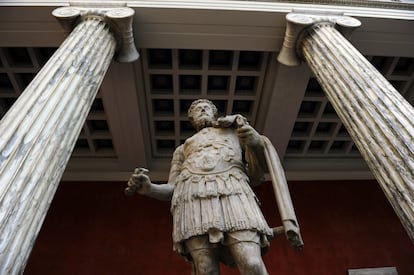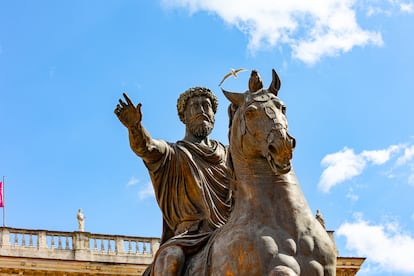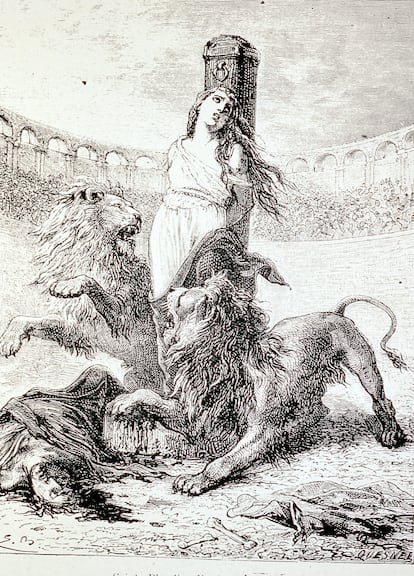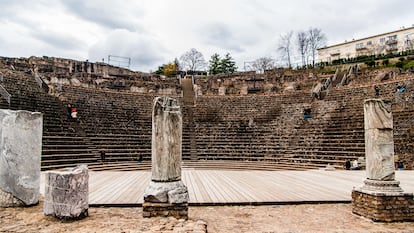Massacring Christians: A stain on the legacy of Marcus Aurelius as Rome’s ‘enlightened emperor’
History remembers the famed ‘philosopher-king’ as a wise and just ruler, but one of the most brutal and well-documented acts of imperial atrocity took place under his reign: the torture and persecution of the martyrs of Lyon, devoured by wild beasts in AD 177

More than any Roman emperor, Marcus Aurelius (121-180) evokes the archetype of a wise and virtuous ruler – skilled in the art of fair judgment, a serious and sensible politician, a man who went to war courageously but reluctantly, and always for the good of the Empire. Aurelius’ writings on stoic philosophy, collected in the book Meditations, is still printed and sold to this day. The work’s Spanish translation, to cite just one example, is available in no less than eight different editions (not counting a manga version). But the life of kings and saints is not often as rosy as popular history remembers it. Under the reign of Marcus Aurelius, one of the most brutal and well-documented campaigns of state terror and religious persecution was carried out against the empire’s Christian subjects: the famous martyrs of Lyon, who were tortured and devoured by wild beasts in 177, to the delight of audiences that never tired of calling for blood.
From Edward Gibbon’s The History of the Decline and Fall of the Roman Empire, published in the mid-19th century, to the 1964 film The Fall of the Roman Empire, in which Alec Guinness stars as Emperor Aurelius, to the more recent Hollywood hit Gladiator (2000), in which the great philosopher-king is played by Richard Harris – the famed emperor of the Antonine Dynasty has but one blemish on his record: that his successor was his son Commodus, one of the worst emperors in history, as cruel and crazy as Nero or Caligula. Indeed, in the beginning of Ridley Scott’s acclaimed film Gladiator, the script exonerates Aurelius even of that blemish, recounting the emperor’s intention to name his best general, Maximus Decimus Meridius, played by Russell Crowe, as his successor.

In Scott’s film, when Commodus realizes he is to be cast aside, he strangles his own father and then tries to kill Maximus, who survives only to be enslaved and forced to fight for entertainment as a gladiator. Maximus eventually avenges the murder of his family, fighting his way to the Colosseum, humiliating Commodus, and proclaiming his true identity and loyalty in a spectacular cinematic climax: “My name is Maximus Decimus Meridius, commander of the Armies of the North, General of the Felix Legions and loyal servant to the true emperor, Marcus Aurelius. Father to a murdered son. Husband to a murdered wife. And I will have my vengeance, in this life or the next.”
Gibbon goes even further, portraying the reign of Marcus Aurelius as the happiest period in the history of the human race, an honor, according to the British historian, shared with five other emperors of the Nerva–Antonine dynasty: Nerva, Trajan, Hadrian, Antoninus Pius and Lucius Verus: “If a man were called to fix the period in the history of the world, during which the condition of the human race was most happy and prosperous, he would, without hesitation, name that which elapsed from the death of Domitian to the accession of Commodus,” writes Gibbon. “The vast extent of the Roman empire was governed by absolute power, under the guidance of virtue and wisdom. The armies were restrained by the firm but gentle hand of four successive emperors, whose characters and authority commanded involuntary respect.”
“Marcus’ own life (121–80) spanned almost three-quarters of this epoch while his reign (161– 80) occupied its last 19 years,” writes historian Anthony Birley in his 1968 biography of the emperor, a book whose back-cover summary says it all: “A portrait of an emperor who was human and just – an embodiment of the pagan virtues of Rome.” Birley continues: “It was in describing Marcus’ death, and the accession of his son Commodus, that Cassius Dio, born soon after Marcus’ accession, wrote: ‘My history now descends from a kingdom of gold to a kingdom of iron and rust, as affairs did for the Romans at that time.’” Curiously, Birley notes, none of these esteemed emperors was the son of his predecessor, “hence it seemed to some contemporary observers and to many subsequent commentators, including Gibbon, that a new principle was then governing the imperial succession: ‘the adoption of the best man.’ In fact there was no principle or conscious policy at work.”

As wise as he was, Marcus Aurelius lived during violent times, and his life and reign were marked by constant war. The emperor was tasked with defending the borders of the Empire from barbarian attacks – a conflict reconstructed with force and detail in the opening scenes of Scott’s film. It was also a time when Christians faced intense persecution and lived in fear of being tortured and torn to pieces by wild beasts: after a period of relative tranquility following Nero’s campaign of anti-Christian terror, those accused of professing the faith confronted yet another period of persecution – not so much an organized campaign as a haphazard atmosphere of violence that ebbed and flowed depending on who was in power, or how intense the citizen denouncements were. In his biography, Birley recounts how hatred toward Christians was widespread at the time, noting that even Rome’s most esteemed intellectuals – men like Tacitus, Pliny and Suetoniusm, scholars who we continue to read and admire centuries after their deaths – “regarded Christians as pernicious and deserving death.”
Mar Marcos, a professor of ancient history at Spain’s University of Cantabria, says that Marcus Aurelius was not an especially ferocious emperor vis-à-vis the practitioners of what, at the time, was generally considered to be a strange new cult. “There is no evidence that Marcus Aurelius made any changes to the policy towards Christians practiced by his predecessors, which consisted in periodic punishments meted out in response to citizen complaints,” Marcos says. “There was certainly no campaign of ‘persecution.’ There are no legislative documents pertaining to Christians from the time when Marcus Aurelius was emperor. What we know about his attitude toward Christians comes only from the literature of Christian apologetics and their accounts of martyrdom, which are generally unreliable. Indeed, in his Meditations, Marcus Aurelius even expresses a sort of admiration for the stoic predisposition of Christians toward martyrdom.”
But it was under Marcus Aurelius’ watch that the martyrs of modern-day Lyon (known at the time as Lugdunum) were condemned to suffer horrific deaths. “Of the several accounts we have of Christian martyrdom under the rule of Marcus Aurelius, the account of the martyrs of Lyon is the most extensive,” says Professor Marcos. “The document has a very special format – a letter from the Christians of Gaul to the Christians of Asia Minor, which details the facts of the event, and in particular, the methods of torture. The document lists the names of the martyrs, most notably an enslaved woman named Blandina, who, the account claims, showed great fortitude of spirit. The Roman citizens were beheaded while the non-citizens were thrown to the beasts before a large audience in the amphitheater. The document circulated during antiquity, and had a significant impact on the Christian community. The account is still quite chilling to read.”

Researcher Douglas Boin, a professor of ancient history at Saint Luis University and the author of Coming Out Christian in the Roman World: How the Followers of Jesus Made a Place in the Caesar’s Empire, has a similar perspective: “Punishments were most likely no more lethal or cruel under Marcus Aurelius than during other times in Roman history, for other criminals,” he says.
“Rome’s treatment of criminals, including slaves and non-citizens, was always brutal and savage, with a standard menu of sadistic punishments – whippings, being burnt alive, being nailed to the cross and the like – which were used to deter insurrections, slave revolts and other outbreaks of rebellion,” Boin says. “Christians arrested in Lyon would have been subjected to some or all of these tortures, especially if they did not enjoy the rights of being a Roman citizen, and sources indicate that many did not. For criminals condemned by the Roman Empire, being thrown to the beasts was always a very real possibility. So yes, it’s true: the emperor who became famous for his reflections on how to be a just and even-handed ruler presided over an empire whose citizens delighted in the blood shows of the amphitheater.”
Like Professor Marcos, Boin says that most of what we know about these events comes mainly from Christian writers, who used the incidents as propaganda, recounting stories of martyrs who faced torture and savage beasts with bravery, and without renouncing their faith, or, as in the case of Saint Blandina, managed to fend off the animals with their power of spirit – though she, too, was ultimately torn to pieces by a wild bull. Such stories helped to consecrate the mythology of a religion still in its formative stage. “For the Romans, what happened at Lyon was a glorious spectacle; for the Christians, it was martyrdom,” says Boin. “But as a question of history, the heroes and villains are hard to identify. Even the role of the so-called ‘enlightened emperor’ remains unclear.”

Tu suscripción se está usando en otro dispositivo
¿Quieres añadir otro usuario a tu suscripción?
Si continúas leyendo en este dispositivo, no se podrá leer en el otro.
FlechaTu suscripción se está usando en otro dispositivo y solo puedes acceder a EL PAÍS desde un dispositivo a la vez.
Si quieres compartir tu cuenta, cambia tu suscripción a la modalidad Premium, así podrás añadir otro usuario. Cada uno accederá con su propia cuenta de email, lo que os permitirá personalizar vuestra experiencia en EL PAÍS.
¿Tienes una suscripción de empresa? Accede aquí para contratar más cuentas.
En el caso de no saber quién está usando tu cuenta, te recomendamos cambiar tu contraseña aquí.
Si decides continuar compartiendo tu cuenta, este mensaje se mostrará en tu dispositivo y en el de la otra persona que está usando tu cuenta de forma indefinida, afectando a tu experiencia de lectura. Puedes consultar aquí los términos y condiciones de la suscripción digital.
More information
Últimas noticias
Welcome to the post-religion era: The idea of Christianity as the absolute truth has become obsolete
‘I thought you would like it’: The risky sexual practice popularized by TV shows and TikTok
The digitalization of tourism: ‘They promise experiences and gave us the worst possible one’
Mexican peso defies uncertainty with forecasts of a new period of stability in 2026
Most viewed
- Sinaloa Cartel war is taking its toll on Los Chapitos
- Reinhard Genzel, Nobel laureate in physics: ‘One-minute videos will never give you the truth’
- Oona Chaplin: ‘I told James Cameron that I was living in a treehouse and starting a permaculture project with a friend’
- Why the price of coffee has skyrocketed: from Brazilian plantations to specialty coffee houses
- Silver prices are going crazy: This is what’s fueling the rally











































